Canon EOS 850D Rebel T8i review
-
-
Written by Gordon Laing
Intro
The Canon EOS 850D, or Rebel T8i as it’s known in North America, is a mid-range DSLR with a 24 Megapixel APSC sensor, 7fps bursts, cropped 4k video and a fully-articulated touchscreen. It sits at the top of the triple-digit EOS or Rebel series, which puts it directly below the EOS 90D. Announced in February 2020, it got a little lost amongst the initial EOS R5 teasers, then didn’t actually make it to the shops until the following Autumn, but it’s here now so in this review I’ll show you what it can do, crucially when compared to the higher-end EOS 90D. So does the 850D or T8i achieve a sweet-spot of price-performance, is it worth spending the extra on the 90D, or does a mirrorless camera now make more sense for you? Let’s find out!
My full review with sample images, movies and head-to-head comparisons is in the video below, but if you prefer a written version, keep scrolling!
Note: it drives everyone mad to keep repeating the multiple names of these more affordable Canon DSLRs, so from this point on, I’ll just be calling it the EOS 850D, but remember everything I say and show you, equally applies to the Rebel T8i as it’s exactly the same camera.
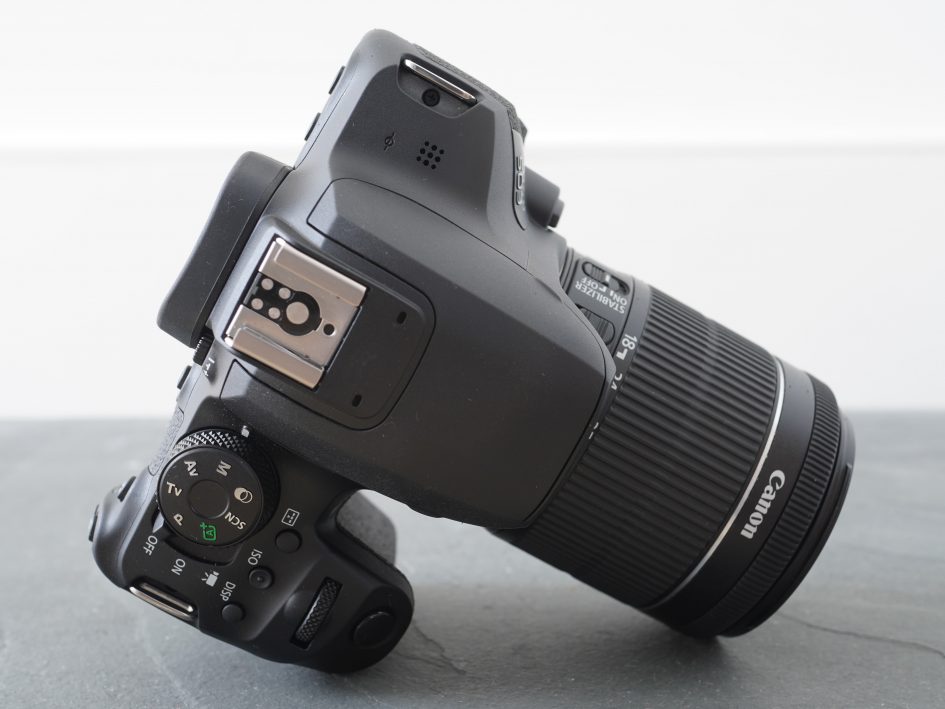
Depending where you live, the 850D costs roughly two thirds the price of the EOS 90D, but is remarkably close to the EOS M6 II body making it a tempting alternative. I’m also going to throw the EOS M50 into the mix, a compact mirrorless camera that like the 850D also has a 24 Megapixel sensor and fully-articulated screen, but comes with a wider 15-45mm kit zoom. Meanwhile if you’re after Canon’s cheapest interchangeable lens camera with an APSC sensor and viewfinder at the time of testing, that’ll be the EOS 2000D or Rebel T7.
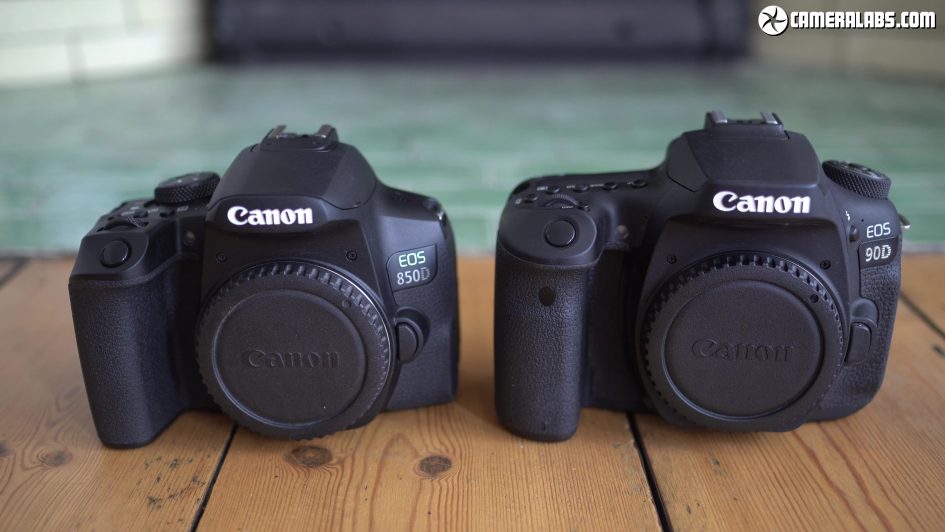
Above: Here’s the 850D on the left and the 90D on the right, where it’s clear the 850D is the smaller camera, but not by a huge margin. It’s a little shorter and a tad thinner, but the biggest size difference is the width which is about one centimeter less. Weight-wise there’s a more noticeable difference, with the 850D body plus battery weighing-in at 515g making it almost 200g lighter than the 90D.
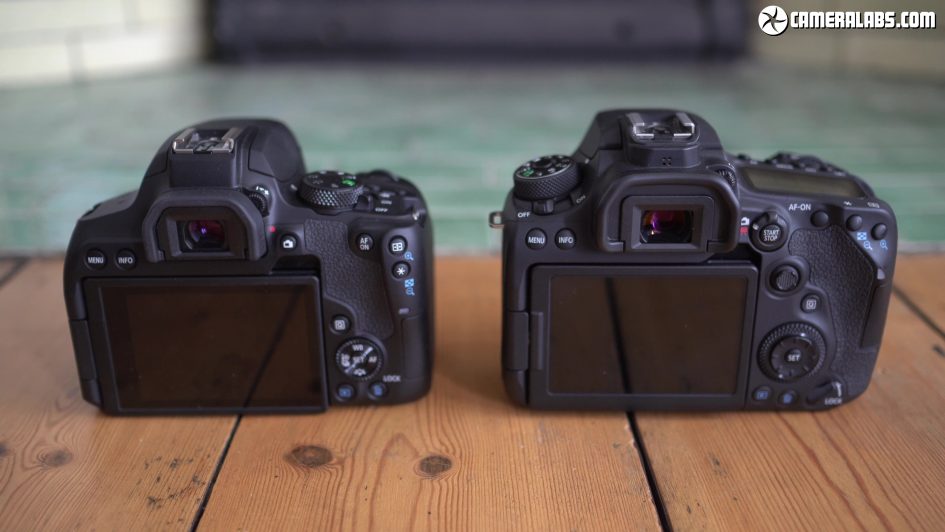
Above: In your hands, the 90D definitely feels a little heftier, but in a more substantial, positive way. The deeper grip of the 90D with larger grippier surfaces to wrap your hands around felt better to me personally, while the slightly larger size didn’t make much difference in my bag. I certainly see the appeal of smaller cameras, but if you want a significant difference, I’d suggest a mirrorless model like the EOS M50.
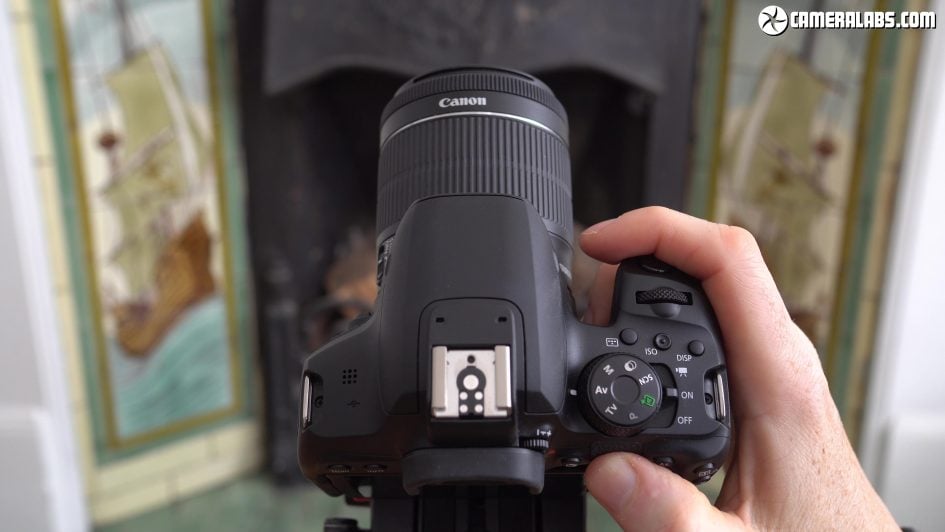
Above: In terms of controls, the 850D’s unlockable mode dial is positioned on the right side with a chunky switch that powers it on for stills, then switches it to movies. There’s a finger dial by the clicky shutter release and round the back a small thumb wheel which doubles as a rocker. Meanwhile three buttons on the upper surface are dedicated to adjusting the AF area, ISO and display mode.
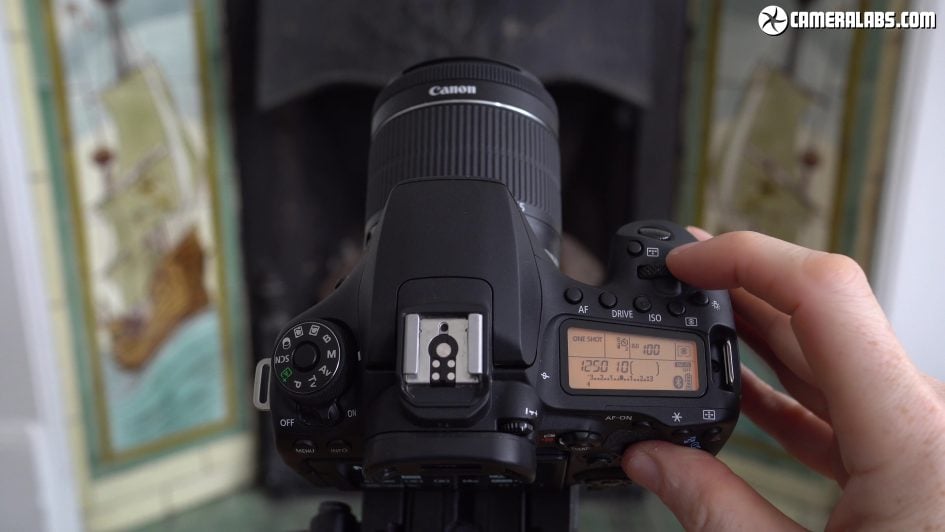
Above: For comparison, here’s the 90D’s controls starting with its mode dial on the upper left side surrounded by a chunky power switch. Unlike the 850D, the mode dial is locked to prevent accidental turns and you need to push down on a central button to free it. The position of the mode dial on the left frees-up the entire right surface for an LCD status display which shows a wealth of shooting information at a glance. Like the 850D there’s a front finger dial, but the rear thumb wheel is larger with more positive feedback and a rocker within. Unlike the 850D, the 90D also sports an AF joystick as well as a control by the viewfinder that switches the camera between stills and movies. The shutter release is also a soft-touch model unlike the clicky 850D button, while there’s now four buttons dedicated to adjusting the autofocus and drive modes, ISO and metering. As always it’s down to personal preference, but I much preferred the 90D’s controls over the 850D.
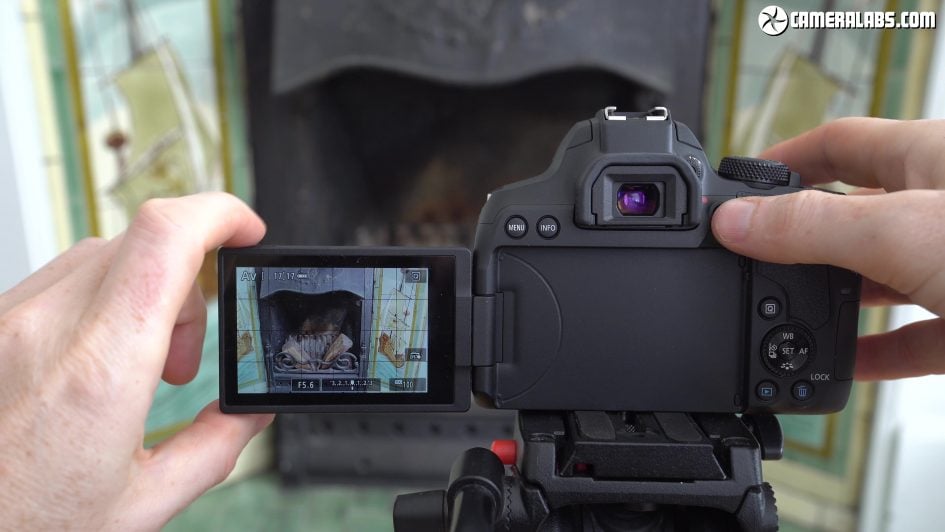
Above: Round the back, the 850D is equipped with a side-hinged fully-articulated screen that’s perfect for selfies, vlogging and filming pieces to camera, as well as twisting for comfortable shooting at any angle whether in the landscape or portrait orientation. Side-hinged screens may require two actions versus one for a tilting mechanism, as well as moving away from the optical axis and sometimes obstructing ports too, but I still prefer their flexibility. The 90D shares the same flexibility but with a slightly larger 3.2in panel versus 3in on the 850D, although both have the same 1040k dot resolution.
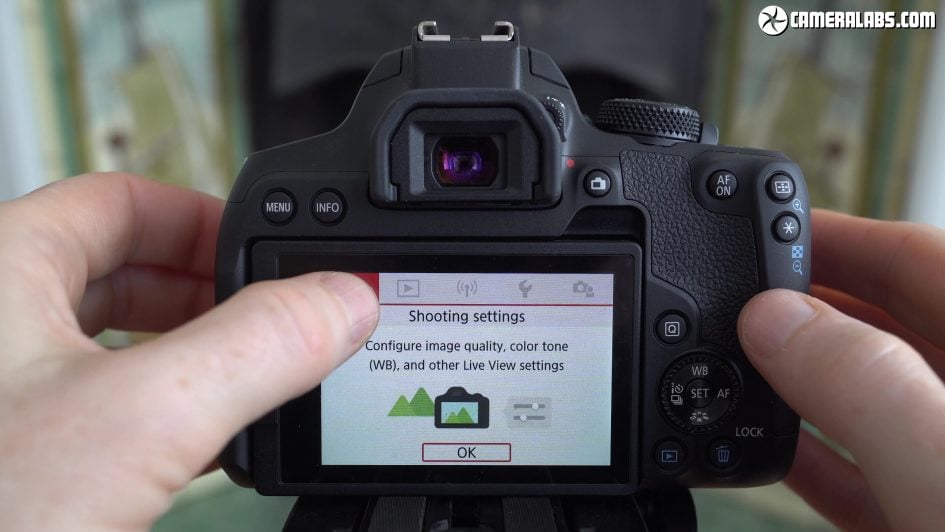
Above: Canon’s touch interface is one of the best around. You can fully navigate the Quick menus by touch if desired, as well as tapping to reposition the focusing area. The main tabbed menu system also works by touch, and is surprisingly easy to navigate and select this way, even though you can use physical buttons if you prefer. Meanwhile in playback you can swipe through images before pinching to zoom, dragging around and double-tapping to return again. It all feels very intuitive and responsive.
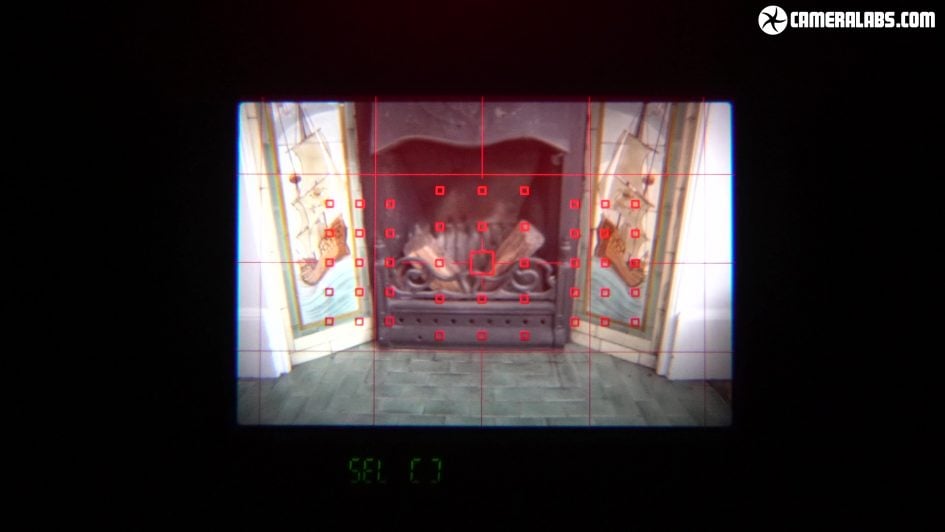
Above: As a DSLR, the 850D is equipped with a traditional optical viewfinder for composition, inside which you’ll see the viewfinder autofocus system and the lozenge area it occupies. Like other members of the same series, Canon’s stuck with a penta-mirror system which on the 850D delivers a fairly small magnification of 0.82x and 95% coverage. The 90D’s penta-prism viewfinder delivers a noticeably larger view with 0.95x magnification and 100% coverage too for more accurate framing, but unlike the electronic viewfinders of mirrorless cameras, you can’t use an optical viewfinder for playback, adjusting menus or doing anything with video. Again it boils down to personal preference, but I prefer electronic composition, although when tracking erratic seagulls I did enjoy the absolute absence of lag on these optical viewfinders.
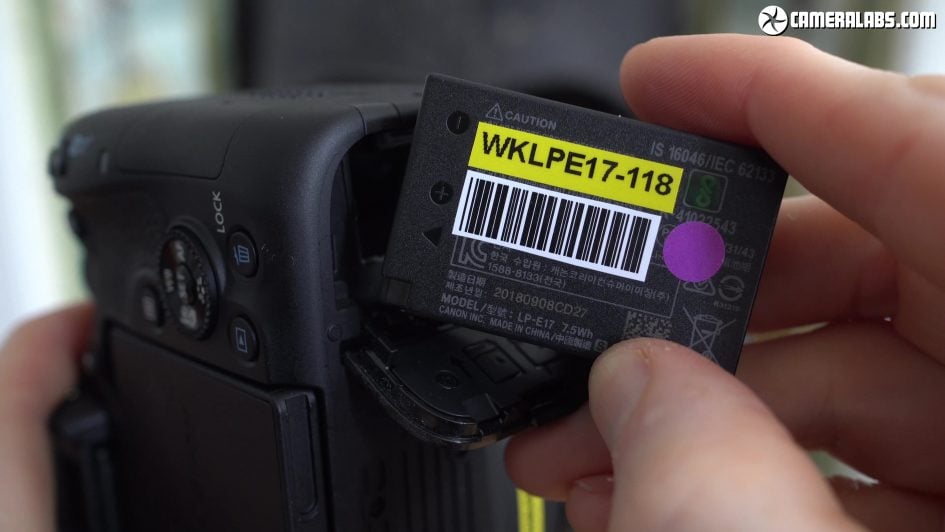
Above: The 850D is powered by the LP-E17 battery that claims around 800 shots with the optical viewfinder or 300 in live view, compared to the slightly larger LP-E6N pack in the 90D which claims 1300 shots through the viewfinder. If you’re able to shoot mostly with the optical viewfinder, both will outlast a mirrorless camera with 100% electronic composition, although in terms of video life, I still managed two and a half hours of 1080 25p on a single change on the 850D or just over four hours on the 90D, albeit split into half hour clips. Annoyingly neither camera can be charged internally over USB, so you’ll need to use the supplied AC adapter.
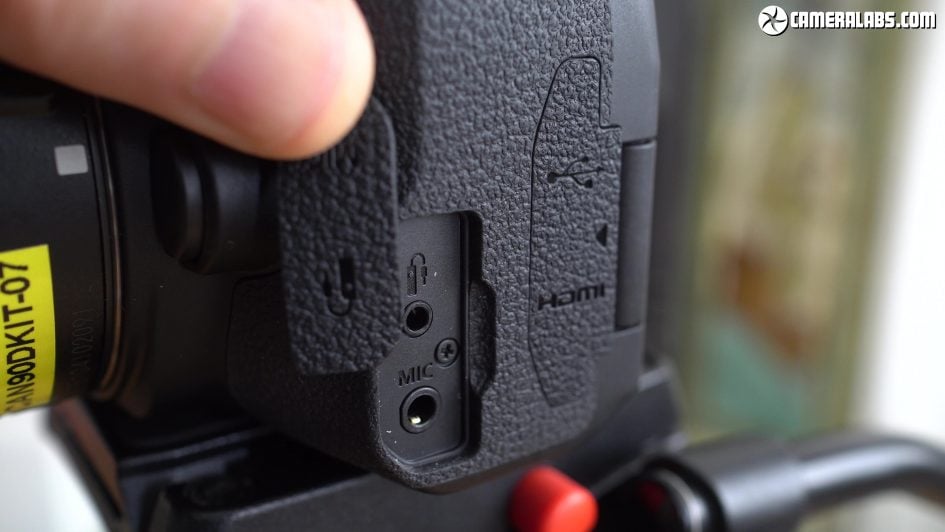
Above: Two rubber flaps hide the 850D’s ports. Behind one is a simple cable release port alongside a microphone input, the latter positioned low to considerately minimise obstructions with the screen hinge when filming. Behind the second flap is a Micro USB port which can be used for data, remote control or webcam streaming, but again not charging, while below it is a Mini HDMI which can deliver a clean output. The 90D shares the same USB and HDMI connectivity, but adds a headphone jack, making it a better choice for more serious videographers. As far as wireless is concerned, both offer Wifi with Bluetooth for easy phone connectivity.
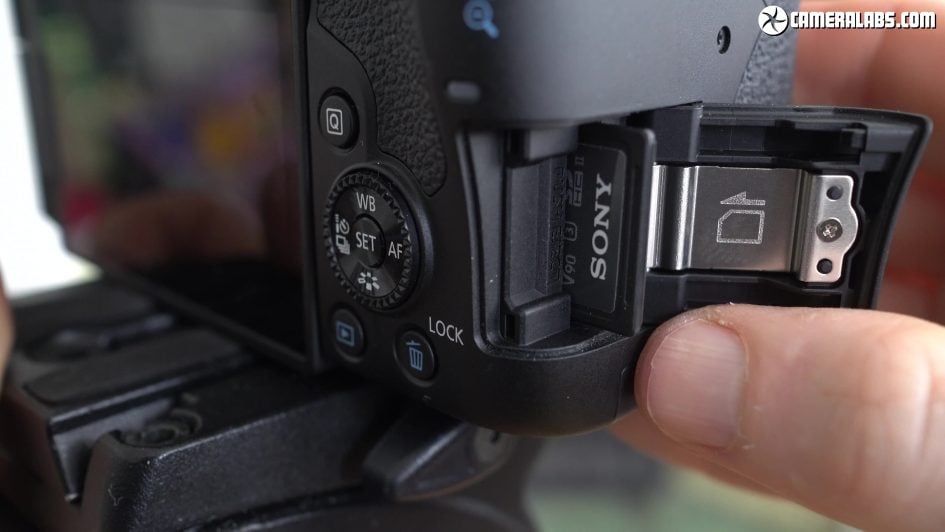
Above: In terms of memory the 850D is equipped with a single SD card slot – the same as the 90D, although it runs slower, unable to exploit the extra speed of UHS-II cards. A small bonus point to the 90D then, although that camera really should have had twin SD slots.
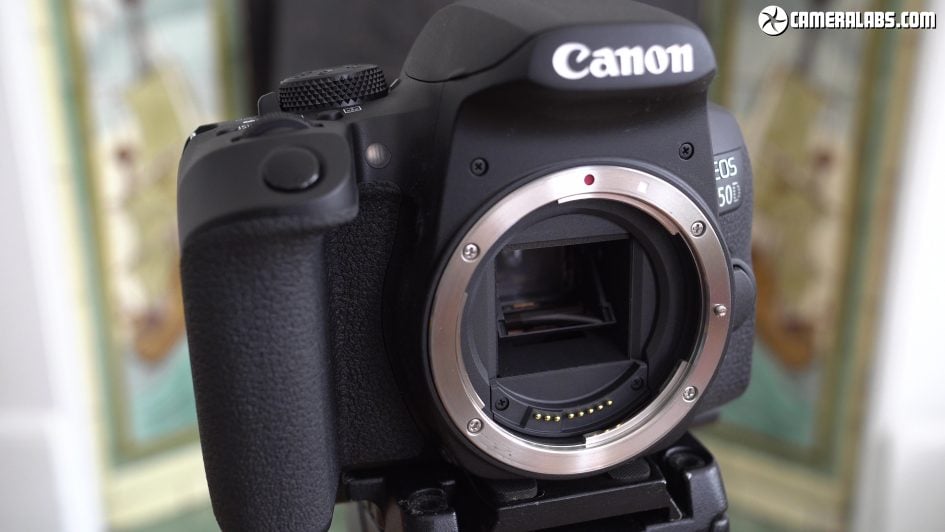
Above: As a Canon DSLR, the 850D is of course equipped with an EF lens mount, and as an APSC model, it’s also compatible with EF-S lenses; anything you mount will have the field of view reduced by 1.6 times. It’s easy to skip-over the lens mount on Canon DSLRs, but it provides access to one of the broadest range of lenses, not to mention a thriving third-party and second hand market. If you’re wondering what lens to buy next, how about the EF 50mm f1.8 STM for exploring portraits and shallow depth-of-field effects, or perhaps the EF-S 10-18mm STM for ultra-wide landscapes, architecture and vlogging, and neither model will break the bank.
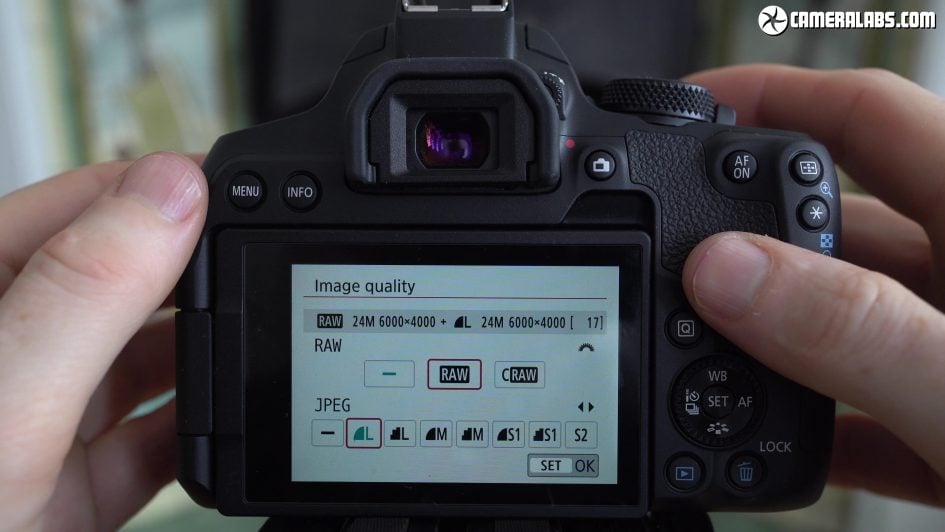
Above: Behind the DSLR mirror is a 24 Megapixel APSC sensor which again reduces the field-of-view of all lenses by 1.6 times, so the 18-55mm kit zoom becomes equivalent to 29-88mm. Like all Canon DSLRs to date, the sensor is not stabilised within the body. It delivers images with 6000×4000 pixels, saved in JPEG, RAW or both, and the output is familiar from numerous earlier Canon bodies that shared the same sensor, including the EOS m50. But after sticking with 24 Megapixels for its APSC sensors for some time, Canon introduced a new 32.5 Megapixel sensor in 2019 which made its debut on the 90D and M6 II; this capture images with 6960×4640 pixels.
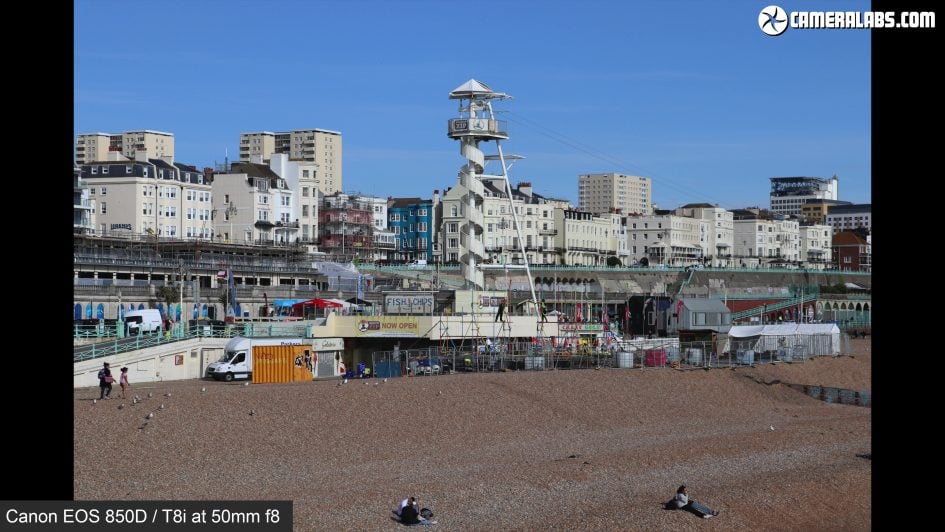
Above: To find out how they compare, I shot the same outdoor scene with both the 850D and 90D moments apart and fitted with the same EF-S 18-135mm kit zoom set to 50mm f8. Here’s the 850D version, and zooming-in reveals plenty of fine detail. But how much more detail can you expect from the 90D?
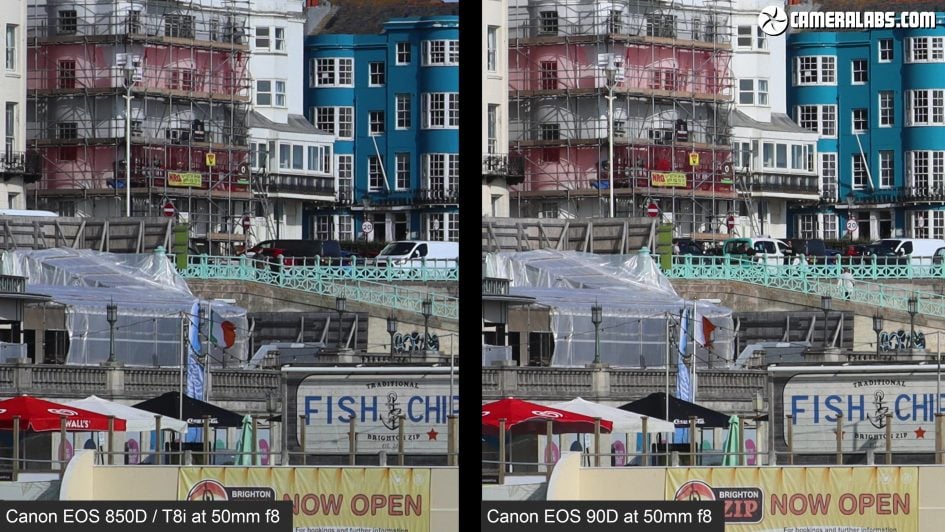
Above: Here’s the 850D on the left and the 90D on the right, both JPEGs out of camera and scaled to the same height where the most striking thing is how similar their output looks, give or take a little difference in contrast due to lighting. The 90D’s sensor may sport roughly 15% more pixels in the horizontal and vertical axes, but fit them with the same kit zoom and you’re unlikely to notice any actual difference, and even with higher quality optics, the benefit of the 90D and M6 II over 24 Megapixel models is subtle to say the least.
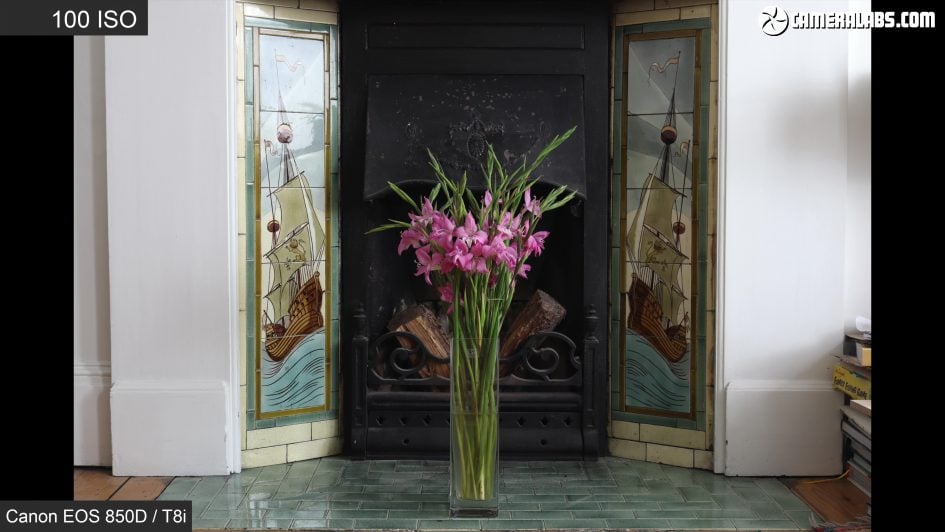
Above: How about noise levels throughout the sensitivity range? To find out, I shot this still-life with both cameras, again moments apart with the same EF-S 18-135mm kit zoom, this time at 35mm f8 and at all sensitivities.
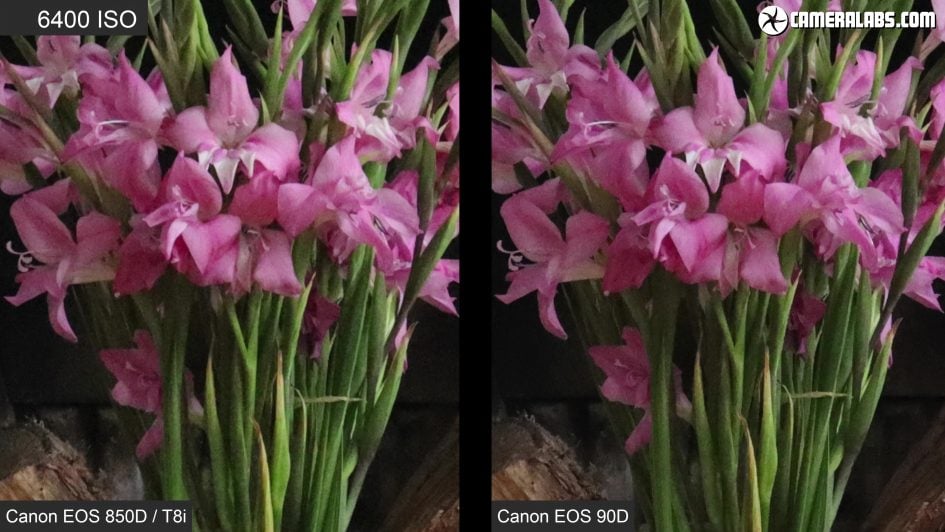
Above: Now let’s take a closer look at the results from both cameras with the 850D on the left and the 90D on the right, starting at 100 ISO and increasing to 25600 ISO; the full sequence is available in my video review above. These are JPEGs out of camera as support for RAW from Adobe was not available at the time of testing. There’s small differences in their style, but again the overwhelming outcome is how similar the two cameras look when their images are presented at the same size, and while RAW may unlock some detail, it’s likely to keep them on a roughly level playing field. So in terms of image quality, the 90D and M6 II may technically out-resolve 24 Megapixel models on resolution charts with decent lenses, but in real-life situations you’re unlikely to notice much if any difference.
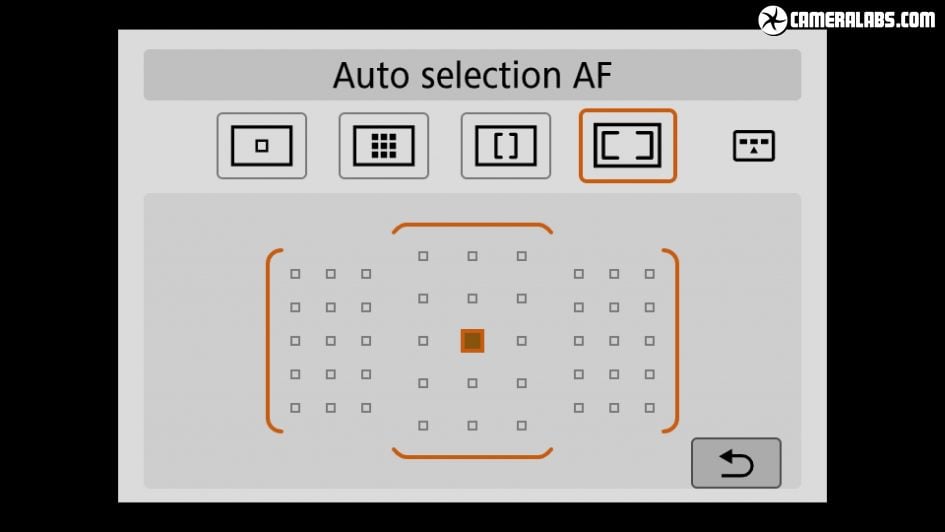
Above: Both the 850D and 90D share the same viewfinder AF system, a 45-point all cross-type array that, like most DSLRs, occupies a lozenge-shaped area concentrated in the middle of the frame. The 850D lets you switch between a single AF area, zoned or the entire array, to which the 90D adds a smaller spot-area option, but the number and arrangement of points remains the same.
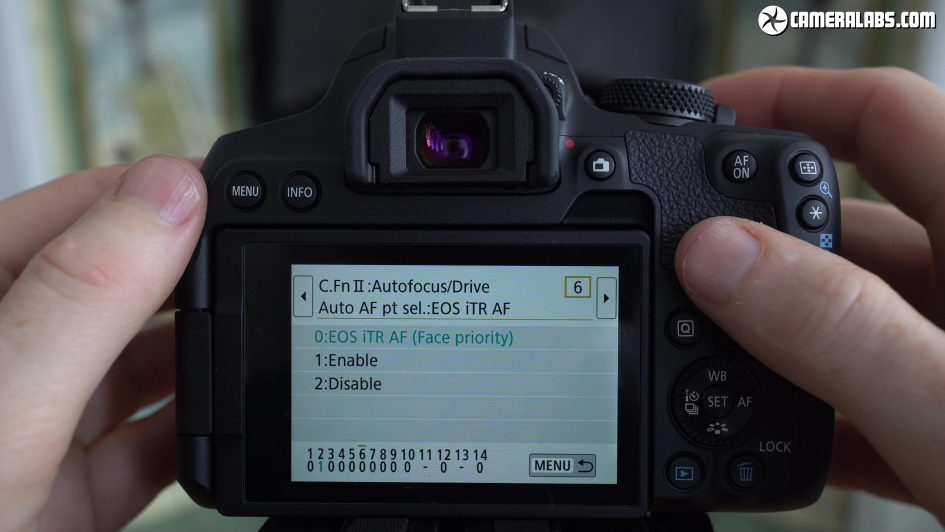
Above: Interestingly both cameras offer basic face detection with their viewfinder AF systems, driven by their fairly high resolution metering sensors. This is enabled by default from the custom menus and works fairly well, at least within the portion of the frame covered by the AF array.
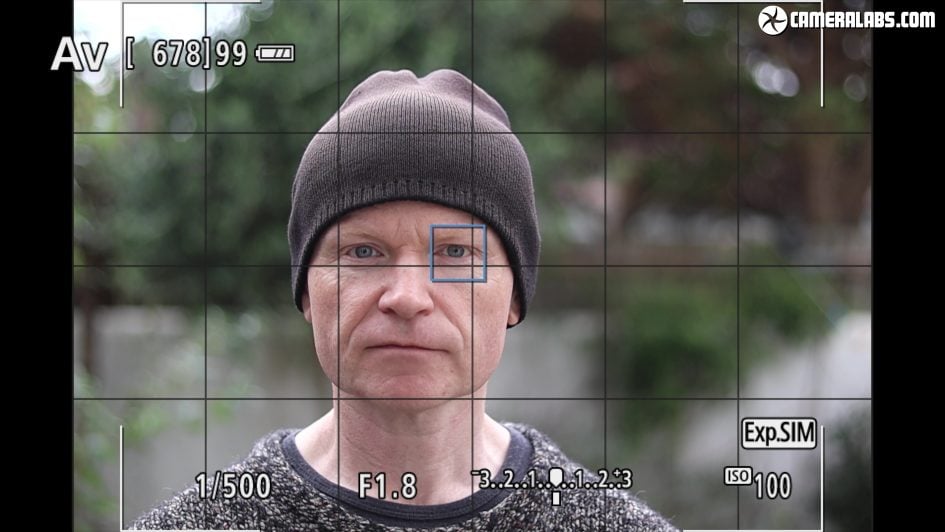
Above: Switching to live view with composition using the screen only unlocks far more sophisticated face and eye detection that works across most of the frame. It’s driven by Canon’s Dual Pixel AF which even in the mark I version here provides confident results. I’m using it here with the EF 50mm f1.8 STM lens for a more challenging test. Like the 90D, the most sophisticated autofocus modes on the 850D are in Live View, but as DSLRs this is not available when composing with the viewfinder. For me this is one of the major benefits of mirrorless cameras which provide their best AF performance whether you’re using the screen or viewfinder.
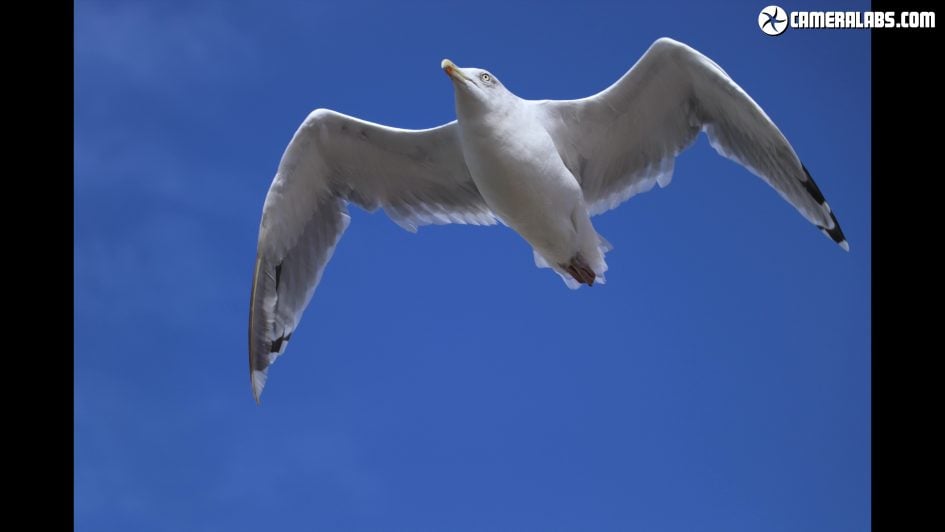
Above: In terms of bursts, the 850D can fire-off long sequences of JPEGs or RAW files at up to 7fps with the viewfinder with single or continuous Servo autofocus. Here’s a frame from a burst with the 850D and EF-S 18-135mm, set to 135mm f5.6 and using the viewfinder AF system. Checking the timestamps of the images confirms the 850D can maintain 7fps with continuous Servo AF, at least when shooting with the optical viewfinder. While I personally prefer electronic composition overall, I did enjoy the complete absence of lag when following the seagulls with an optical viewfinder. That said, the 90D is the better action camera, not only shooting faster at 10fps, but also offering a 1/8000 shutter speed that’s twice as quick as the 1/4000 maximum of the 850D. And for times when you need to be discreet, the 90D also offers a silent electronic shutter option in live view, although in my tests it proved very susceptible to skewing from rolling shutter.
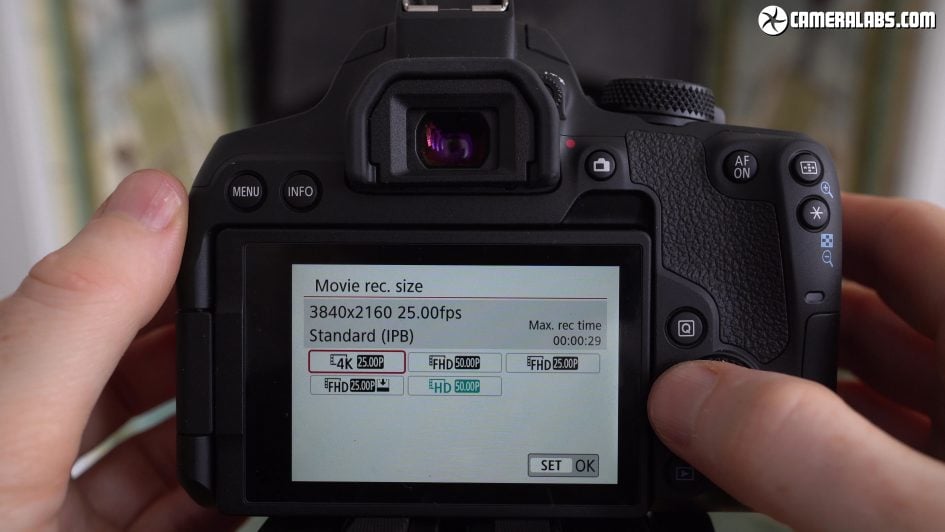
Above: Moving onto video, the 850D can film uncropped 1080 at 25 or 50p when set to PAL, or at 24, 30 or 60p when set to NTSC; nice to see Canon remembering to include 24p on a new camera without facing the wrath of youtubers. 4k is also available at 24 or 25p when set to NTSC or PAL respectively, but both with a substantial crop of around 1.5 times. 4k is also limited to less confident contrast autofocus, leaving the superior Dual Pixel autofocus to 1080 video only. Sadly there’s also no frame rates higher than 60p on the 850D, so no chance for slow motion beyond a 2x slow-down
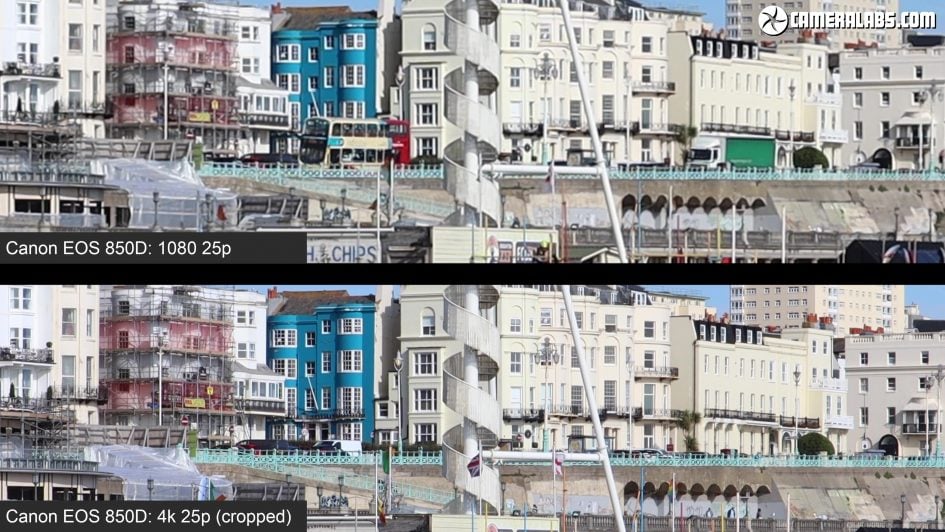
Above: Ok now for some comparisons, starting with the 850D in 1080 at 25p and forgive me for the slightly wobbly footage as the pier was being battered by the sea. This was filmed at 50mm. Now for the same view with the 850D in 4k at 25p without adjusting the field of view to illustrate the crop when filming in this mode. But is it resolving finer detail? To find out, here’s the 1080 clip in the top half and 4k clip in the bottom half, with the zoom adjusted on the latter to match the field of view. You’ll need a high res display to see the difference, but the 4k is definitely recording greater detail, albeit with the caveats mentioned.
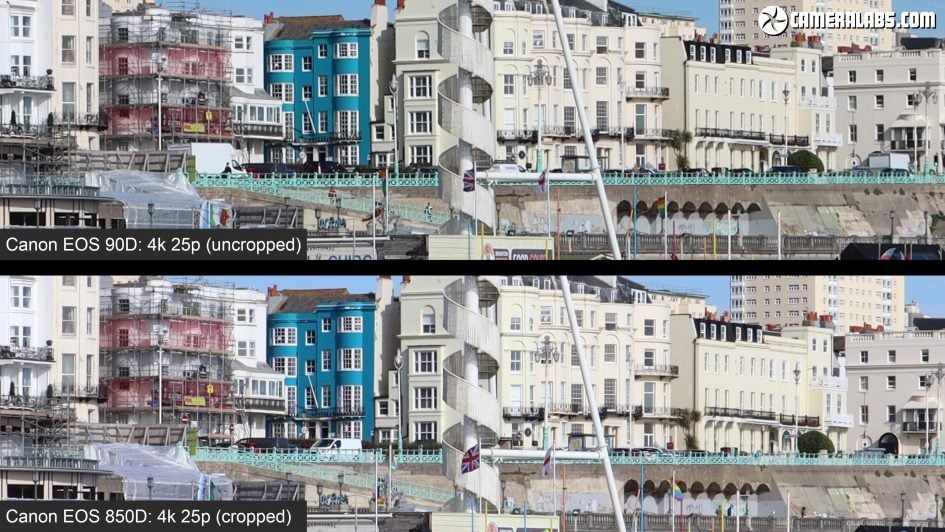
Above: Is the 90D any better? Here it is filming 1080 at 25p at 50mm, and now filming 4k 25p again at 50mm. Yes, the 90D offers uncropped 4k and in a further bonus over the 850D also supports dual pixel autofocus, making it much more practical. For comparison, here’s the 850D’s cropped 4k in the bottom half, while in the top half is the 90D’s uncropped 4k, and you may be surprised to see the 850D may actually be delivering finer detail. This is due to the way each camera scales the sensor data to deliver a 4k frame and if you prefer, the 90D alternatively offers a cropped 4k mode.
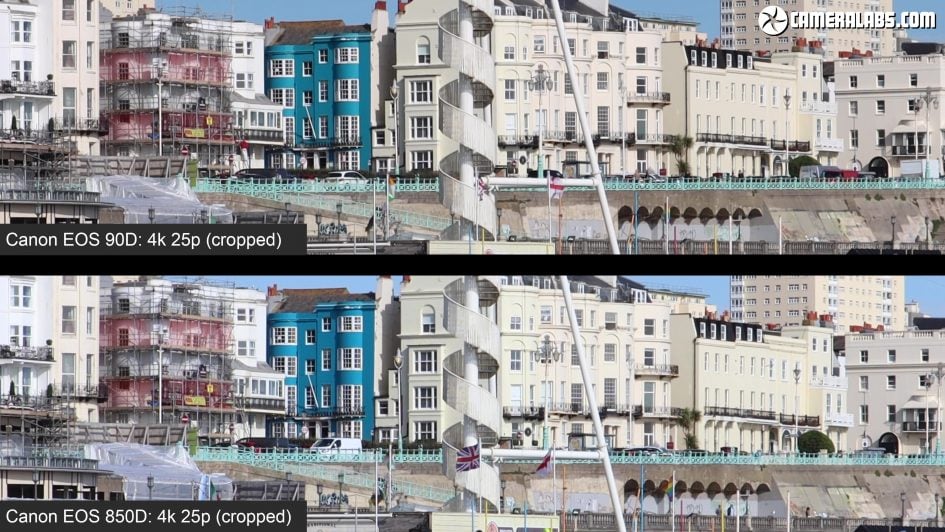
Above: So here’s the 850D’s cropped 4k in the bottom half, but now with the 90D’s cropped 4k in the top half, both scaled to deliver the same field of view. The impact of video processing can be confusing, but with the choice of cropped or uncropped 4k, dual pixel AF in 1080 and 4k, as well as slowmo 1080 that’s absent on the 850D entirely, the 90D is the more capable camera for video.
But while the 850D may fall behind the features of the 90D, it’s still a capable camera for video, especially in 1080. Dual-pixel autofocus works very well in 1080p, using the touch screen to confidently pull-focus. 4k can also work well for simple focus-pulls despite using a contrast-based AF system. Moving targets are where dual pixel really shows a noticeable lead though. So like Canon’s other 24 Megapixel models to date, 4k video on the 850D isn’t particularly practical and unless you really understand its limitations and how to work around them, it’s best to think of the 850D as a 1080 camera only. If you want more usable 4k from Canon, you’ll need the 90D or M6 II, or consider a Sony like the A6400.
If you’re into posting video on social networks, you will however appreciate the ability to film in the vertical format and have it stay this shape, and thanks to easy wireless and a decent app, it’s straightforward to get them onto your phone for sharing.
Check prices on the Canon EOS 850D / Rebel T8i at B&H, Amazon, Adorama or WEX! Alternatively get yourself a copy of my In Camera book or treat me to a coffee! Thanks!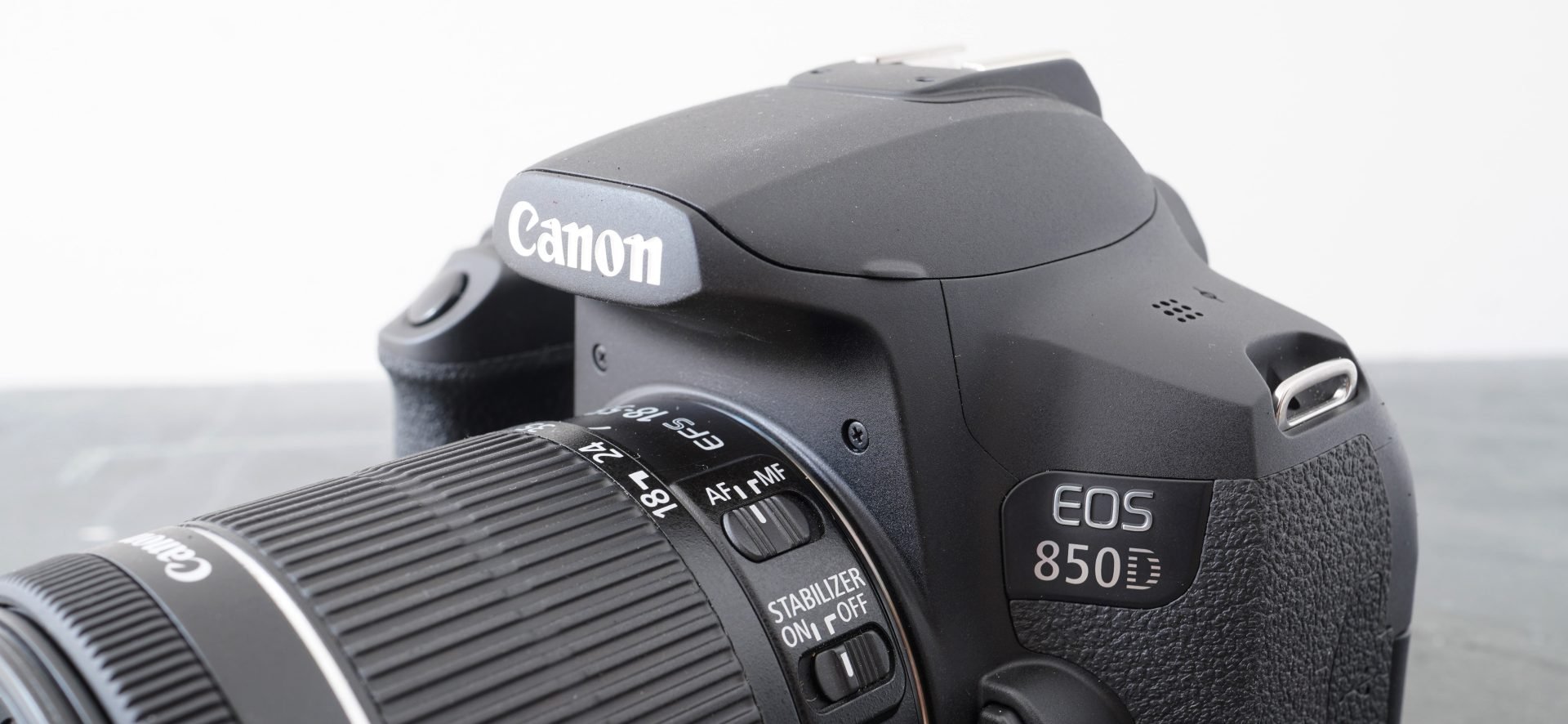
 The Canon EOS 850D / Rebel T8i is a well-featured mid-range DSLR that sits at the top of the triple-digit EOS or Rebel series. It delivers a comfortable step-up in features and handling over the cheaper entry-level models, making it a good choice for anyone who wants a decent DSLR without breaking into four figures. As always though, Canon offers a wide range of models at different price points, each offering a tempting stepping-stone to the next level. The EOS 90D is arguably its biggest rival, and while the boost in resolution make little difference in real-life, it’s the wealth of smaller upgrades that make it worth investing in the higher price. Meanwhile the mirrorless M6 II may lack a viewfinder as standard but gives you a lot of the 90D at the same body price as the 850D / T8i. There’s also the older M50 sporting a viewfinder, fully-articulated screen and the same photo and video quality of the 850D in a smaller body at a lower price - and with a wider kit zoom too. Ultimately the EOS 850D / Rebel T8i is a fine DSLR and one that performs well for the money - and if you’re after a Canon DSLR at this price point, I can recommend it. But again if you’re looking for a longer-term investment to grow with, you’ll find the 90D more powerful overall, so if you can stretch to it, I’d strongly recommend taking the leap.
The Canon EOS 850D / Rebel T8i is a well-featured mid-range DSLR that sits at the top of the triple-digit EOS or Rebel series. It delivers a comfortable step-up in features and handling over the cheaper entry-level models, making it a good choice for anyone who wants a decent DSLR without breaking into four figures. As always though, Canon offers a wide range of models at different price points, each offering a tempting stepping-stone to the next level. The EOS 90D is arguably its biggest rival, and while the boost in resolution make little difference in real-life, it’s the wealth of smaller upgrades that make it worth investing in the higher price. Meanwhile the mirrorless M6 II may lack a viewfinder as standard but gives you a lot of the 90D at the same body price as the 850D / T8i. There’s also the older M50 sporting a viewfinder, fully-articulated screen and the same photo and video quality of the 850D in a smaller body at a lower price - and with a wider kit zoom too. Ultimately the EOS 850D / Rebel T8i is a fine DSLR and one that performs well for the money - and if you’re after a Canon DSLR at this price point, I can recommend it. But again if you’re looking for a longer-term investment to grow with, you’ll find the 90D more powerful overall, so if you can stretch to it, I’d strongly recommend taking the leap.



